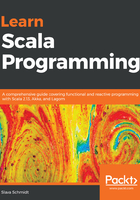
上QQ阅读APP看书,第一时间看更新
Products can report the names of their element
This feature probably will be mostly useful for the case classes as it makes possible some generic programming without the need to resort to reflection or macros.
The following examples demonstrate how the new productElementName(idx) method can be used to build a naive JSON serializer for simple case classes:
case class User(name: String, surname: String, email: String)
def naiveToJsonString(p: Product): String =
(for { i <- 0 until p.productArity } yield
s""""${p.productElementName(i)}": "${p.productElement(i)}"""")
.mkString("{ ", ", ", " }")
Obviously, this simple iteration does not take nesting and escaping into account, but it already can produce valid results in elementary cases:
scala> val user = User("John", "Doe", "jd@mail.me")
user: User = User(John,Doe,jd@mail.me)
scala> naiveToJsonString(user)
res1: String = { "name": "John", "surname": "Doe", "email": "jd@mail.me" }
Unfortunately, the method taking an index of the element throws an exception in the case that the index is invalid:
scala> user.productElementName(3)
java.lang.IndexOutOfBoundsException: 3
at User.productElementName(<console>:1)
... 38 elided
We will discuss why throwing exceptions is not the best approach, as well as viable alternatives, in Chapter 6, Exploring Built-In Effects.